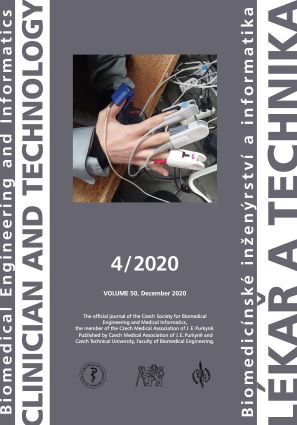COMPARISON OF END-EXPIRATORY LUNG VOLUME MEASUREMENT BY ELECTRICAL IMPEDANCE TOMOGRAPHY AND NITROGEN WASHOUT METHOD IN PIGS
DOI:
https://doi.org/10.14311/CTJ.2020.4.05Abstract
End-expiratory lung volume (EELV) can be determined using several methods that allow clinically accurate measurements, but it is difficult to apply these methods to the patient's bedside. Electrical impedance tomography (EIT) is offered as another method for measuring EELV. The aim of the study is to compare changes in EELV measured by nitrogen washout method with changes of EELV calculated from the change in end-expiratory lung impedance (EELI) measured by EIT and to determine whether changes in EELV calculated from changes in chest impedance can be used as one of the parameters for EIT data analysis and description. The prospective interventional animal study was performed on ten pigs. The animals received total intravenous anesthesia with muscle relaxation. Mechanical lung ventilation was conducted in the volume-controlled mode. 16-electrode EIT system was used for data acquisition. End-expiratory lung volume was measured by a modified nitrogen wash-in/wash-out technique developed by Olegard et al. The study protocol consisted of the baseline phase, two incremental PEEP steps, two decremental PEEP steps and from normal saline i. v. administration. For each animal, a reference frame (baseline frame) was selected from the initial baseline phase and was used for the reconstruction of EIT images and impedance waveforms. For each breath cycle, tidal variation image was calculated as a difference between the end-inspiratory and the previous end-expiratory EIT image. An equivalent end-expiratory volume change (ΔEELVequiv) was calculated from EELI. The values of ΔEELVequiv were compared with reference EELV data measured by a modified nitrogen wash-in/wash-out technique (ΔEELVmeas). The measured and the estimated changes in EELV were statistically compared and correlation between ΔEELVequiv and ΔEELVmeas was calculated. Statistically significant difference between ΔEELVequiv and ΔEELVmeas was observed only in administration of normal saline bolus. Pearson’s correlation coefficients were 0.29 for increase in PEEP, 0.45 for decrease in PEEP and -0.1 during administration of normal saline bolus. The study showed that during changes in PEEP in the porcine model, there was no linear relationship between ΔEELVequiv and ΔEELVmeas. Although there was no linear relationship between ΔEELVequiv and ΔEELVmeas with changes in PEEP, no statistically significant difference was demonstrated between these two methods, which justifies the use of ΔEELVequiv as a parameter suitable for description and evaluation of EIT data.
Downloads
Published
Issue
Section
License
Copyright (c) 2021 Karel Roubík; Martin Muller

This work is licensed under a Creative Commons Attribution 4.0 International License.
Authors who publish with this journal agree to the following terms:
- Authors retain copyright and grant the journal right of the first publication with the work simultaneously licensed under a Creative Commons Attribution License (https://creativecommons.org/licenses/by/4.0/) that allows others to share the work with an acknowledgment of the work's authorship and initial publication in CTJ.
- Authors are able to enter into separate, additional contractual arrangements for the non-exclusive distribution of the journal’s published version of the work (e.g., post it to an institutional repository or publish it in a book), with an acknowledgment of its initial publication in this journal.
- Authors are permitted and encouraged to post their work online (e.g., in institutional repositories or on their website or ResearchGate) prior to and during the submission process, as it can lead to productive exchanges.
CTJ requires that all of the content of the manuscript has been created by its respective authors or that permission to use a copyrighted material has been obtained by the authors before submitting the manuscript to CTJ. CTJ requires that authors have not used any copyrighted material illegally, as for example a picture from another journal or book, a photo, etc. It is the author’s responsibility to use only materials not violating the copyright law. When in doubt, CTJ may ask the authors to supply the pertinent permission or agreement about the use of a copyrighted material.
The opinions expressed in CTJ articles are those of authors and do not necessarily reflect the views of the publishers or the Czech Society for Biomedical Engineering and Medical Informatics.


